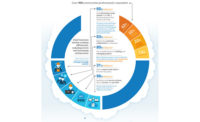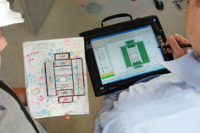CENTERED ON SOLUTIONS
Using Technology to Maximize Profits
Get Organized to Get Profitable

Introduction
This is last in a series of conversations with Norb Slowikowski, president of Slowikowski & Associates. Norb has worked in the construction industry since 1982. He is a renowned productivity expert who has helped more than 300 contractors to improve their productivity to maximize their profitability. He and I have been discussing the importance of organization to the result of profitability. The following is the final part of our second conversation together.
In the first article we discussed how creating processes ensures alignment between the office and the field. This article focuses on:
- Applying job cost management techniques to increase profitability.
- Using technology to leverage current, consistent and accurate information to keep a project on track and to maximize the opportunity for profit.
Job Cost Management
Looking at the costs for any construction job, labor typically totals between 40 percent and 60 percent of the job. Beyond labor, the other large costs that contractors incur are for equipment, tools and materials. For most companies, job cost management is the biggest control for increasing profitability.
With manpower being the largest cost, it is critical for the foremen to understand the labor budget and the labor codes to appropriately track the daily usage of labor. This coding and tracking allows a contractor to know at any point in time whether they are under, on or over budget for manpower. Knowing this information allows the foremen to make adjustments to the labor schedule as needed before the labor budget gets out of hand.
The chart below illustrates where job site labor is actually spent and illustrates the consequences of not having proper job controls in place.
There is a now forgotten study that shows that crews spend 64 minutes or 14.6 percent of their day looking for materials, and 34 minutes or 7.8 percent of the day moving materials from one part of the job to the other. This is a significant amount of time to waste. It represents money that is lost from the contractor’s profit margin, and in some cases it could even be larger than the company’s expected profit for a job. Organizations that can apply the proper job controls to activities like looking for and moving materials will keep their crews more productive and moving in the direction they need to be.
While there are back office systems to manage job cost accounting, job costs are directly impacted by the effectiveness of the key job controls that are in place. These processes and controls help ensure that the job site work process flows smoothly from beginning to end and that costs are well managed.
Technology to Improve Productivity and Protect Profit
At the job site, productivity rests in the hands of the foremen. In the office, the focus on productivity involves better estimating, planning and back office support. Both office and field personnel can increase productivity by leveraging the latest technologies to organize project steps, manage processes and share project-related information—from estimation through onsite supervision and on to project completion.
Contractors that use automation have done much to improve their “office-based” estimation and bid management processes. These integrated tools enable estimators to develop more precise takeoffs and detailed bids in significantly less time compared to doing it manually, and just as importantly, they allow contractors to:
- Save time and money—Reduce the cost of shipping and printing plans. Spend far less time doing takeoffs and estimating costs for each bid. Submit more bids to win more projects.
- Reduce costly mistakes—Eliminate manual entry errors and see visually on the screen that everything is accounted for, which decreases the likelihood of having to perform “value engineering” to recoup lost revenue and cost from an error filled bid.
- Improve collaboration—Get everyone in the company on the same page for how to bid and work a job.
- Differentiate from competition—Submit bids, respond to change requests and offer alternatives quickly and with confidence.

However, this is just the front end of any project. The big opportunity for productivity improvement lies in making this detailed project information available where it is needed most: in the hands of the foremen as they walk around the job site.
With powerful yet inexpensive Windows-based tablets and highly intelligent applications contractors can put all the project related information, job cost management, and planning and materials management in their foremen’s hands in a consistent format that drives repeatable construction processes and controls.
With these tools, a contractor’s most valuable field resources can literally walk around the job and have the ability to get to all the vital information more quickly, and to more efficiently answer questions, resolve issues and generally keep the project on track.
Information Packages
A tried and true method of providing foremen with job information has been on paper, often in a three ring binder. Many experienced foremen would be loath to try to get by without their binders. However, the information contained within those sacred binders is static and often out of date.
With integrated systems and tablet PCs, contractors can provide this same information to their foremen in a more productive, efficient and consistent way. This can be accomplished with construction automation solutions.
In addition to takeoffs and drawings, which we covered in “Get Organized and Get Profitable”—earlier articles, additional critical parts of the “complete information package” that can be managed with automation include:
Scope of Work: Norb pointed out that it’s very important to have a clearly defined scope of work. The best way to accomplish this is to begin with a color-coded copy of the takeoff. Many companies print these out, but automation customers can get the same information digitally with the free plan viewers. With free technology, foremen will have read-only access to all job related takeoffs, which are easy to view on a Windows-based tablet PC wherever the foremen are working.
Bid Summary Report: After the Scope of Work, this report is the second most import piece of information in the information package. The report not only shows the scope of work for the job and its sub-components, but just as importantly shows what the big dollar risk items are. As a result, this report helps foremen better manage project risks and protect the project’s profitability.
Job Cost Summary Report:The job cost summary report is a valuable tool for the entire project team, from back office to the field. It presents labor budgets broken down by area/activity with all the codes that activities are to be charged to, raw labor cost, man-hours, as well as the production rate per hour. From this information the foremen can develop their weekly and two week plans.
As foremen walk the job site with this information at their fingertips, they can select an area that is to be started within the next three weeks—say, for example, deck high walls—to visually see the drawing for this activity and drill down to see exactly how many hours are required to complete the task. This information can then be copied directly into upcoming work plans and assignments.
Stocking Lists:The information package also should contain the stocking list which tells foremen exactly what they are going to need to build out the job. These reports can be broken down into various levels of detail—for example, the entire job, a particular floor, or just one room. Having this kind of granular view on a tablet PC allows the foremen to walk the job site and view the labor budget required for an area as well as the corresponding material requirements. The foremen can then plug this information into their look-ahead plans and order materials as they are needed instead of ordering everything at once and having to worry about storing it.
Planning and Job Cost Management
When foremen are provided budgets and other reports printed on paper, they are static reports. In fact, the information may be outdated by the time the foremen get the reports. What’s more, when the foremen jot notes on the paper reports, there are no updates being made to supporting systems and there is no way of seeing how a change will impact another area of the project. The foremen must wait until information is submitted to the office, processes are run and new reports are sent back to them—sometimes taking days—to know where they stand on their budgets. Waiting days for outdated information is no way to run a business today.
Using a tablet PC, foremen can update many facets of their project—from granular resource plans, to percent completion of the associated resource assignments—and receive instant visualization of where they stand on every phase of their project responsibilities. It’s the best way to stay connected to the project’s current status.
Planning: When planning tasks and manpower resources, technology allows foremen to view their resource requirements in numerous ways, such as by labor code for an overall budget view, or by specific area such as a room or floor on a takeoff drawing. The area view provides foremen a count of workers needed to complete an area of work in a certain period of time. It also can tell the foremen that if they apply “x” number of men, it will take “y” number of days to complete the tasks. This is a wonderful “what if” tool that helps with resource management and planning.
For example, there are instances where a foreman knows that he “must” complete framing a floor by the end of the week, but he sees that there are more man-hours required to get this done than what he currently has assigned. Instead of “guesstimating” the number of framers needed, automation will tell the foremen exactly how many framers are needed to complete the floor by the week’s end.
Further, automation is a valuable tool for the foremen when working with the GC to create two week look-ahead plans. Foremen will be able to know whether or not to agree to the GC’s suggested plans and show the GC if he does “x,” the resulting number of hours that go into an activity may require too many men for the foremen to agree to due to various issues, such as safety and timing with other trades being in the area at the same time. In this instance, the automation allows foremen to have informed conversations with the GC and other trades about what the consequences changes and other trades’ performance issues are actually doing to the overall project—and the contractor’s bottom line.
Budget Percentage Complete: As mentioned earlier, foremen can create their resource plans through technology. They also can track their completed task percentage as they are walking the job. Foremen can simply select an area of work from the takeoff drawing that represents what that they are standing in front of, and enter what the estimated percent complete is for what the foremen see in front of them. This could be anywhere from 1 to 100 percent. Software then updates, in real time, all the related portions of the project plans and budgets. This current information is now available to all people, from the foremen to the accountants, to use immediately instead of having to wait for timecards and job sheets to be submitted, processed and sent back at a later time.
With the percentages of completions applied, technology provides foremen numeric and graphical views of where they stand on their project. Specifically, they know in real time whether they are meeting, exceeding or are behind on their budgets by various filters such as: day, week, project, labor code, and areas of the project such as floors or rooms. At the end of the job, the information gathered using automation is extremely important during the post job reviews and provides estimators insights on how to refine their production rates in their estimating processes.
Requests for Information
Many times during a day, foremen need answers to questions that don’t require an immediate response. These questions are mainly handled via RFIs. Before tablet computers and construction automation, foremen would typically go to the job office or trailer, type up an RFI on the PC and submit it as an email to all the relevant parties. With technology on the job site floor, the foremen can select copy current view of a report, drawing, or an actual picture and paste the information into an RFI template, enter their question or comments and send it to the right people so they can address the issue. The RFI function within the software allows the foremen to submit an RFI where they stand, instead of writing a note and waiting to go back to the trailer.
Conclusion
Having well established processes, job controls, as well as providing consistent information to foremen on tablets is about empowerment and improved productivity. It’s about communicating. It’s about improving the flow of information. It’s about giving the project leaders the tools they need to be effective. A company that can effectively integrate these practices will improve its efficiency and ultimately its bottom line.
Getting organized is not always easy, but it’s a necessary skill for achieving desired results.
Looking for a reprint of this article?
From high-res PDFs to custom plaques, order your copy today!






